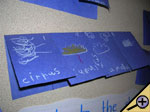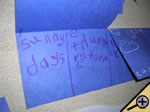 The Teacher's Corner
The Teacher's Corner
Earth Science Lesson Plans
![]()
![]() This indicates resources located on The Teacher's Corner.
This indicates resources located on The Teacher's Corner.
![]() Apple Earth Grades 4th-6th
Apple Earth Grades 4th-6th
Use apples to teach longitude and latitude, as well as the composition of the Earth. This is also a great activity to open discussion on water conservation
Submitted by: The Teacher's Corner
![]() Andes Mountains Grades Middle School
Andes Mountains Grades Middle School
A tasty graphing and elevation activity. I teach seventh grade Geography, and we have been studying the Andes Mountains in South America. To study the elevations of the mountains, you can use Andes chocolate thin mints to build the elevations or use the chocolate on a bar graph illustrating the different elevations. Afterwards, the students love to eat their pieces of their Andes Mountains.
Submitted by: Lee Ann Williams - Dyersburg, TN
![]() Beach Ball Toss Grades 3-5
Beach Ball Toss Grades 3-5
This is a fun activity to use during a study of the Earth. "To give the students a sense of the proportions of the earth that are land and water, we toss a beach ball that's decorated as the globe. These are available inexpensively. As they catch the ball, they must report whether their hands land on earth or on water. I keep track of it on the board. After every child has a turn, we tally up the results. Surprisingly, this works successfully. As an extension, the student can call out the name of the continent on which their hand lands."
Submitted by: Carol Berlin c.berlin@email-removed , a third grade teacher at Charlotte A. Dunning School in Framingham, Massachusetts. This tip was published in the NEA's Weekly Tip Newsletter.
![]() Does air have mass? Grades Intermediate
Does air have mass? Grades Intermediate
A great lab for students.
Submitted by: Amy Spock mrs.spock@email-removed
![]() Earth Day Unit
Earth Day Unit
Our complete Earth Day thematic unit.
![]() The Ecosystem Grades 3-5
The Ecosystem Grades 3-5
Summary: A great activity to incorporate the all time favorite, 'I Know an Old Lady Who Swallowed a Fly' into your classroom.
At the beginning of the school year, I introduce food chains to the students by having everyone, including myself, recite 'I Know an Old Lady Who Swallowed a Fly.' We all have a good time with that humorous poem. Now that the class is exploring tropical rain forests, our poems have become a little more serious and mysterious like this one that I created in direct connection to one of the pages in our science textbook. It's called 'Eek! Eek! The Ecosystem!'
The plants eat the sunshine and the water,
The beetle dines on leaves beside her daughter,
The furry spider eats both insects like she ought to,
A boa swallows them in one gulp for nutrients and water,
And as the chubby snake rests, a hawk awaits the slaughter.
Moral
A rain forest rule that helps species survive:
It's better to pray to eat prey than to pray while being eaten alive.
One thing I remind students is that humans are not in any other animal's food chain. We just have to be careful not to whet a hungry animal's appetite.
Submitted by: Michael Szewczyk Cooper198@email-removed , a fourth grade teacher at Berkeley Terrace School in Irvington, New Jersey. This tip was published in the NEA's Weekly Tip Newsletter.
![]() Ecosystems - Biomes
Ecosystems - Biomes
Our complete Biomes thematic unit.
![]() Environment Activity Using the Internet Grades 3-5
Environment Activity Using the Internet Grades 3-5
Combine two of the most important topics of today. My fourth grade class gets with a partner and they go to the website Earth Dog. This is a 20 page picture book (between 3rd and 4th grade reading level) about a dog who falls into a polluted stream and gets saved and turns into the hero "Earthdog" and goes around and saves the earth. The students read the book together and then write their own book about an environmental hero who saves the earth from some type of pollution. They name their own character and then write and illustrate their book. This takes about a week having the students work about 45 minutes a day. Then they share their books with the other students and we put them in the library for checkout. Some students went on to write more books about the environment and favorite heroes.
Submitted by: Cheryl CDarbys383@email-removed
![]() Food Webs Grade 4
Food Webs Grade 4
Students will delve deeper into the concept of ecosystems in the exploration of the interdependence of living elements within the tropical rain forest ecosystem.
Submitted by: Michele O'Connor mocon800@email-removed
![]() Habitats Grades 2-4
Habitats Grades 2-4
Summary: A great idea for your study of habitats. It provides students with visual and hands-on activities.
We study four habitats at the beginning of second grade. I decorated one window in my room with a fish net strung from one side to another. I had a plastic crab, seahorse and swordfish entangled in the net. I set up shells of all kinds in the ledge. A banner was put in it saying we're going to have an ocean of fun. My other window was the rainforest. I took brown bulletin board paper and twisted it to create vines. I added leaves to it and put it around my window. I had colorful plastic frogs sitting on the ledge. At the top I had a sign "At Home in the Rainforest". Colorful plastic canvas magnets toucans, monkeys, parrots, frogs were put around the window . Books about the ocean and rainforest were displayed in the area of those windows. My bulletin board gave space for the forest and desert. Students work of squirrel nests and owls helped to create the forest. On my table I put material( purchased from Wal-Mart) of colorful fish on a pretty blue background.
Submitted by: pwelch@email-removed
![]() Ice & Snow Unit
Ice & Snow Unit
Our complete Ice and Snow thematic unit.
![]() Learning about Rainbows Grades Primary
Learning about Rainbows Grades Primary
Hands-on activity for students learning about rainbows.
I use baby food jars with lids. Fill the jars two thirds full of water. While talking with the children about the colors of the rainbow, ROYGBIV, add a few drops of food coloring to make a jar of each of the colors. Put a little glue around the rim of the jars and screw on the lids. These are great for the kids to manipulate into the correct sequence. They also look really pretty with light shining through them when placed on a windowsill.
Submitted by: Sandy Gabriel - Albany, Illinois
![]() Ocean Unit
Ocean Unit
Our complete Ocean thematic unit.
![]() Plants Unit
Plants Unit
Our complete Plant thematic unit.
![]() Recycling Poem Grades Various
Recycling Poem Grades Various
Summary: Using Shel Silverstein's poem 'Sarah Cynthia Sylvia Stout' is an excellent way to begin a unit on Recycling.
Using Shel Silverstein's poem "Sarah Cynthia Sylvia Stout" is an excellent way to begin a unit on Recycling. Sarah simply refused to take the garbage out. Have the students read this funny poem and decide what Sarah could have done with her garbage. What could have been recycled? What could be put in the compost pile? Poor Sarah met an awful fate for not taking the garbage out. Would we end up like Sarah if we don't care for our environment? The students then make a small closed compost pile or landfill with some of their lunchroom trash and garbage. I have done this in the beginning of the school year and it is interesting to see what has decomposed over the period of a school year and what should have been recycled.
Submitted by: Kathy Davis - West Plains, Missouri
![]() Solar System Unit
Solar System Unit
Our complete Solar System thematic unit.
![]() Tulip Growth Graphs Grades Various
Tulip Growth Graphs Grades Various
Summary: An activity to begin in the fall.
In mid-fall find an out-of-the-way place and have students plant tulip bulbs in a sunny area. In the spring, all the students go out with their notebooks and rulers. Use a popsicle stick marked with group number and have each cooperative group claim one tulip and stick the popsicle stick in the ground to mark it. Have them measure the tallest part of their tulip in inches and centimeters and note them in their notebooks. We record new measurements of the tulips every 6-7 days. From their first measurement (2 inches) to the day the flowers bloom (12+ inches), takes about a month and a half. Each group creates a bar graph to show the dates measured and the tulips’ progress in centimeters and inches. You can make a great spring bulletin board using their graphs, photos and artwork!
Submitted by: Genevieve Petrillo - Belleville, New Jersey
![]() Types of Clouds Grades Any
Types of Clouds Grades Any
Summary: This is an excellent opportunity for students to demonstrate their understanding of the different types of clouds and create a great display for your room.
During a weather unit, students typically learn about the different types of clouds they may see in the sky. This is a great way for students to synthesize this information. The work below was created by a 1st grade class.
Take pieces of blue construction paper, fold in half, and then cut within about 1/4 of an inch of the fold. (You will need to divide the paper into thirds and make just two cuts.) On the outside of the folded paper, students draw and label the type of cloud. On the corresponding inside flap, they "predict" the type of day you would have if this cloud was in the sky.
Submitted by: Jennifer T.
![]() Water Unit
Water Unit
Our complete Water thematic unit.
![]() Weather Unit
Weather Unit
Our complete Weather thematic unit.
 Back to the Science Lesson index
Back to the Science Lesson index
Earth Awareness Enrichment Program Grades K-12
The Earth Awareness program is a traveling interactive enrichment program featuring the Earth Balloon, a 22' model of the earth that students enter to learn about the changing earth. The Earth Balloon is ideally suited for use in earth science, environmental science, pollution, geography, math, etc. Students learn about rain forests, the ring of fire, the solar system, plate tectonics, scale, seasons, timezones and more. The Earth Balloon travels everywhere.
NASA Kids' Club
Learn all about outer space.
Miss Maggie's Earth Adventures
This is a state-of-the-art, animated program that teaches kids about a host of environmental concerns including over fishing, organic farming, animal extinction and more.
Planetpals Earthzone
Planetpals Earthzone is an interactive site featuring characters that help teach kids the importance of caring for our planet and everything in it. Filled with free and fun activities for kids; a valuable source of earth science and ecology information.
Rock Hounds
Dig into this interesting site that contains lesson plans, rock collecting safety tips, online quizzes, and more.
Volcano World
Visit this "erupting" site and find all the volcano resources you need!


